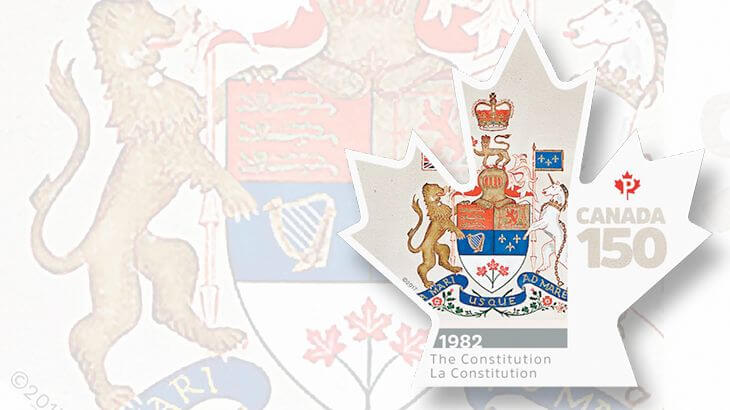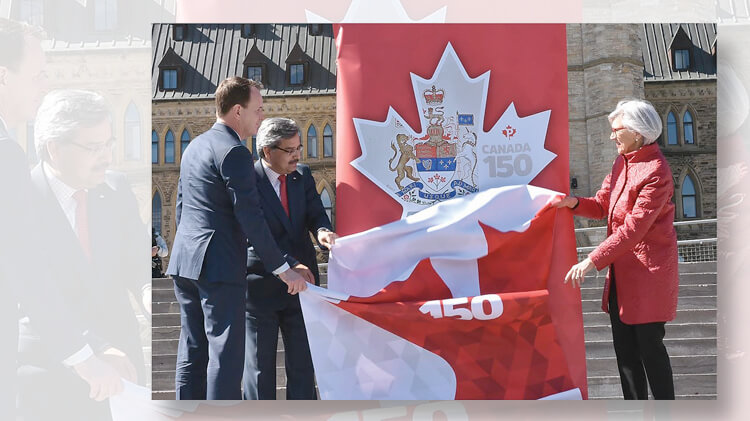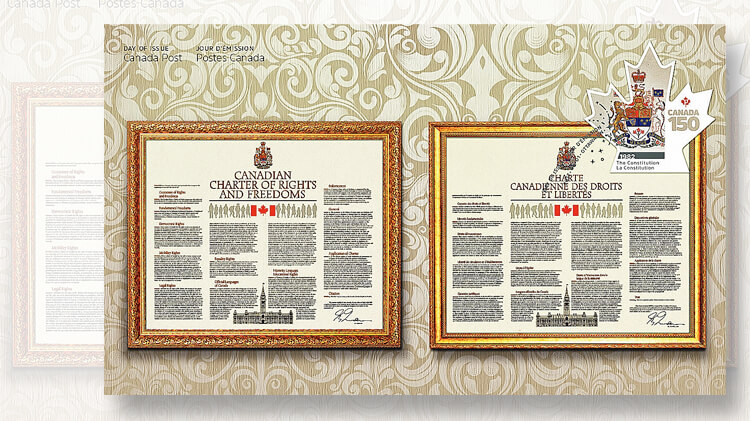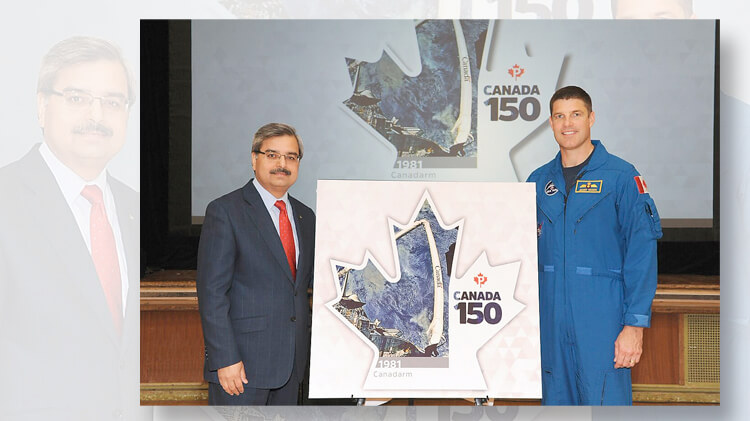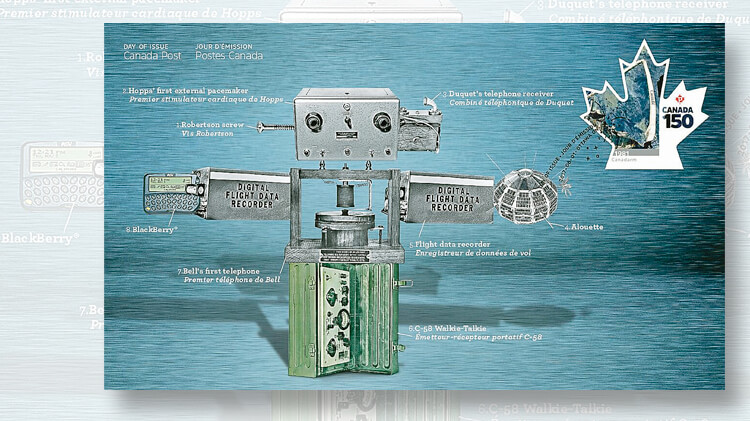World Stamps
Space Shuttle Canadarm, constitution patriation grab Canada 150 spotlight
By Fred Baumann
Unveiled live in Ottawa, Ontario, Canada, and on the Internet May 3 and 4, stamps recalling important innovations in 1982 and 1981, respectively, became the second and third stamp designs revealed to celebrate the 150th anniversary of Canadian nationhood.
These stamps honor the Constitution of 1982 and the Shuttle Remote Manipulator System known as Canadarm.
As part of the celebration of Canada’s 150th anniversary, Canada Post is unveiling 10 stamps between April 27 and June 1. All 10 stamps will be issued June 1.
Connect with Linn’s Stamp News:
Sign up for our newsletter
Like us on Facebook
Follow us on Twitter
Canada Post intends them to “capture unforgettable moments of the last 50 years” as its observance of the Canadian sesquicentennial. The stamps are shaped like Canada’s maple leaf.
On May 3, Beverley McLachlin, the chief justice of the Supreme Court of Canada, took part in the unveiling of a stamp commemorating the patriation of the Canadian Constitution, which took place April 7, 1982.
On the steps of the Center Block of the Parliament Buildings in Ottawa, the Canadian capital, McLachlin spoke briefly of the importance of this foundational document to Canada’s emerging identity and sense of self.
The nondenominated, permanent-rate stamp depicts the royal coat of arms of Canada, a symbol of the nation since 1921. Canada Post’s official first-day cover for the stamp, however, depicts Canada’s Charter of Rights and Freedoms.
A brief synopsis is provided on the Library and Archives of Canada’s website: “By 1967, Canada had its own national symbols and possessed all the powers of an independent nation, with one exception: the power to amend its own Constitution, which could only be done by the British Parliament. Repatriating the Constitution was a long and complicated process.
“The signing of the proclamation on April 17, 1982, marked the end of efforts by many successive governments. The new Constitution was accompanied by The Canadian Charter of Rights and Freedoms, and an amending formula that would no longer require an appeal to the British Parliament.”
On May 4, Canada Post President Deepak Chopra and Canadian Space Agency astronaut Jeremy Hansen revealed the third Canada 150 stamp, bearing an image of Canada’s most famous robotics accomplishment — the Canadarm.
#TBT: #Canadarm was previously featured on stamps issued in 1986 and 2000. Learn more about our #Canada150 moment: https://t.co/Bxy6Sixyz4 pic.twitter.com/zCUZ4J2xle
— Canada Post (@canadapostcorp) May 11, 2017
In fact, the unveiling itself was a technical achievement of a sort, having been filmed at Glen Ames Senior Public School April 28.
Hansen was at the school to meet students from its robotics club preparing to travel to California to compete in an international robotics competition. Their challenge was to design, build, and program a robot made of Lego bricks to solve a problem.
What they came up with was PetPortion, a robot that manages a pet’s weight by automatically giving it the proper amount of food based on its weight and daily exercise.
Canadarm made its debut Nov. 13, 1981, during the second mission of the space shuttle Columbia.
The Canada Space Agency said, “The Shuttle’s Canadarm wrapped up 30 years of successful operations when it was retired along with the Space Shuttle program after mission STS-135, which marked the robotic arm’s 90th flight.”
Although Canadarm is retired, the technology lives on. NASA had this to say: “Canadarm, the robotic arm used on the Space Shuttle to transfer cargo and release satellites, was the first of its kind. Built in Canada and sponsored by the Canadian Space Agency, it can reach and move in ways that humans can’t. Canadarm has been such a success that it led to the bigger and better Canadarm2, which is a part of the ISS [International Space Station].”
Canadarm also maneuvered astronauts and cargo, in addition to satellites.
Skeptics may regard the staged stamp reveal as a gimmick, but in fact the filmed event at a Toronto school saluted Canadian technical innovation and proficiency past (the Canadarm), present (astronaut Hansen), and future (those grade-school, pet-feeding robot builders).
The stamp depicts the Canadarm deployed from the space shuttle bay in Earth orbit, with the planet’s surface visible below.
Links to videos, photos, and stamp and first-day cover art for the Expo 67 stamp picturing its on-site Habitat residence unveiled April 27 in Montreal, along with the same for the 1982 Constitution and 1981 Canadarm stamps are available from Canada Post.
The fourth stamp in the Canada 150 pane of 10 will be unveiled Tuesday, May 9.
Roy White and Liz Wurzinger of Subplot Design Inc. in Vancouver, British Columbia, designed the stamps. They were printed by the Lowe-Martin Group. Each stamp measures 40 millimeters by 40mm.
The stamps will be available in self-adhesive form in 400,000 booklets of 10, and in 80,000 gummed panes of 10 stamps “with circle perforations 4.5 cm in diameter,” according to Canada Post.
A total of 10,000 packs of 10 official FDCs — one for each stamp design and each canceled in Ottawa — also will be made available.
By Fred Baumann
Unveiled live in Ottawa, Ontario, Canada, and on the Internet May 3 and 4, stamps recalling important innovations in 1982 and 1981, respectively, became the second and third stamp designs revealed to celebrate the 150th anniversary of Canadian nationhood.
These stamps honor the Constitution of 1982 and the Shuttle Remote Manipulator System known as Canadarm.
As part of the celebration of Canada’s 150th anniversary, Canada Post is unveiling 10 stamps between April 27 and June 1. All 10 stamps will be issued June 1.
Connect with Linn’s Stamp News:
Sign up for our newsletter
Like us on Facebook
Follow us on Twitter
Canada Post intends them to “capture unforgettable moments of the last 50 years” as its observance of the Canadian sesquicentennial. The stamps are shaped like Canada’s maple leaf.
On May 3, Beverley McLachlin, the chief justice of the Supreme Court of Canada, took part in the unveiling of a stamp commemorating the patriation of the Canadian Constitution, which took place April 7, 1982.
On the steps of the Center Block of the Parliament Buildings in Ottawa, the Canadian capital, McLachlin spoke briefly of the importance of this foundational document to Canada’s emerging identity and sense of self.
The nondenominated, permanent-rate stamp depicts the royal coat of arms of Canada, a symbol of the nation since 1921. Canada Post’s official first-day cover for the stamp, however, depicts Canada’s Charter of Rights and Freedoms.
A brief synopsis is provided on the Library and Archives of Canada’s website: “By 1967, Canada had its own national symbols and possessed all the powers of an independent nation, with one exception: the power to amend its own Constitution, which could only be done by the British Parliament. Repatriating the Constitution was a long and complicated process.
“The signing of the proclamation on April 17, 1982, marked the end of efforts by many successive governments. The new Constitution was accompanied by The Canadian Charter of Rights and Freedoms, and an amending formula that would no longer require an appeal to the British Parliament.”
On May 4, Canada Post President Deepak Chopra and Canadian Space Agency astronaut Jeremy Hansen revealed the third Canada 150 stamp, bearing an image of Canada’s most famous robotics accomplishment — the Canadarm.
#TBT: #Canadarm was previously featured on stamps issued in 1986 and 2000. Learn more about our #Canada150 moment: https://t.co/Bxy6Sixyz4 pic.twitter.com/zCUZ4J2xle
— Canada Post (@canadapostcorp) May 11, 2017
In fact, the unveiling itself was a technical achievement of a sort, having been filmed at Glen Ames Senior Public School April 28.
Hansen was at the school to meet students from its robotics club preparing to travel to California to compete in an international robotics competition. Their challenge was to design, build, and program a robot made of Lego bricks to solve a problem.
What they came up with was PetPortion, a robot that manages a pet’s weight by automatically giving it the proper amount of food based on its weight and daily exercise.
Canadarm made its debut Nov. 13, 1981, during the second mission of the space shuttle Columbia.
The Canada Space Agency said, “The Shuttle’s Canadarm wrapped up 30 years of successful operations when it was retired along with the Space Shuttle program after mission STS-135, which marked the robotic arm’s 90th flight.”
Although Canadarm is retired, the technology lives on. NASA had this to say: “Canadarm, the robotic arm used on the Space Shuttle to transfer cargo and release satellites, was the first of its kind. Built in Canada and sponsored by the Canadian Space Agency, it can reach and move in ways that humans can’t. Canadarm has been such a success that it led to the bigger and better Canadarm2, which is a part of the ISS [International Space Station].”
Canadarm also maneuvered astronauts and cargo, in addition to satellites.
Skeptics may regard the staged stamp reveal as a gimmick, but in fact the filmed event at a Toronto school saluted Canadian technical innovation and proficiency past (the Canadarm), present (astronaut Hansen), and future (those grade-school, pet-feeding robot builders).
The stamp depicts the Canadarm deployed from the space shuttle bay in Earth orbit, with the planet’s surface visible below.
Links to videos, photos, and stamp and first-day cover art for the Expo 67 stamp picturing its on-site Habitat residence unveiled April 27 in Montreal, along with the same for the 1982 Constitution and 1981 Canadarm stamps are available from Canada Post.
The fourth stamp in the Canada 150 pane of 10 will be unveiled Tuesday, May 9.
Roy White and Liz Wurzinger of Subplot Design Inc. in Vancouver, British Columbia, designed the stamps. They were printed by the Lowe-Martin Group. Each stamp measures 40 millimeters by 40mm.
The stamps will be available in self-adhesive form in 400,000 booklets of 10, and in 80,000 gummed panes of 10 stamps “with circle perforations 4.5 cm in diameter,” according to Canada Post.
A total of 10,000 packs of 10 official FDCs — one for each stamp design and each canceled in Ottawa — also will be made available.
When each new design is revealed, stamps and FDCs can be preordered online at the aforementioned website. Beginning June 1, these stamps and FDCs will be available at www.canadapost.ca/shop.
Also on June 1, stamps and FDCs will be available by mail order from Canada Post Customer Service, Box 90022, 2701 Riverside Drive, Ottawa, ON K1V 1J8 Canada; or by telephone from the United States or Canada at 800-565-4362, and from other countries at 902-863-6550.
Canada’s stamps and stamp products also are available from many new-issue stamp dealers, and from Canada Post’s agent in the United States: Interpost, Box 420, Hewlett, NY 11557.
MORE RELATED ARTICLES
Headlines
-
US Stamps
Oct 7, 2024, 3 PMMcMurtrie dismissed as APS education director following Sept. 21 arrest
-
US Stamps
Oct 7, 2024, 12 PMVasiliauskas named president of Mystic Stamp Co.
-
US Stamps
Oct 6, 2024, 5 PMApgar souvenir card available
-
US Stamps
Oct 6, 2024, 4 PMFirst Continental Congress and U.N. stamps receive Scott catalog numbers
